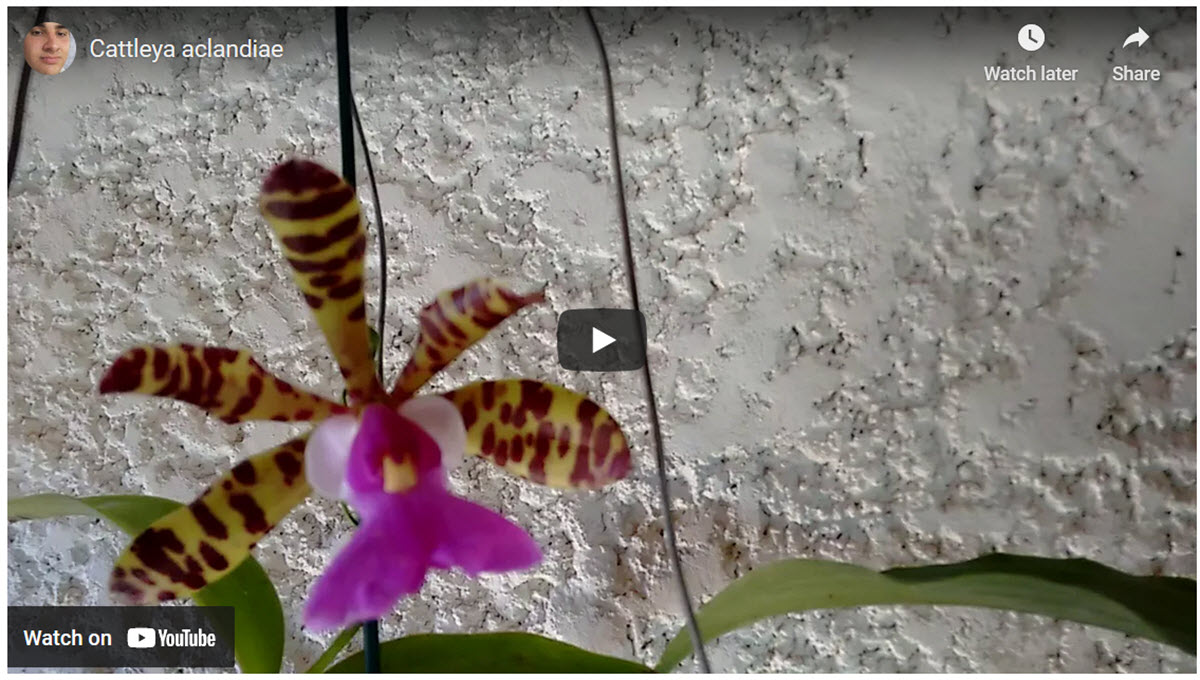Cattleya aclandiae
Contents
Name: Cattleya aclandiae
Size
Cattleya aclandiae is often described as a dwarf orchid and will usually stay around 3-5 in. (7-12 cm), rarely 8 in. (20 cm). It is a compact plant that is much appreciated among growers that does not have a lot of space for their orchids.
Placement
Bright light, ideally 70% of full sun is recommend. Cattleya aclandiae needs brighter light than most other Cattleya species. Proper air circulation is necessary to protect the leaves from sunburn. The pseudobulbs are topped with fleshy leaves that are decorated with black blotches. This blotching tends to increase when the Cattleya aclandiae is provided with a lot of bright light.
Flowers
Considering how small this orchid is, the flowers become very big, often 2 ½ to 4 in. (6-10 cm). Flowers are waxy with a mild, spicy scent. The blooms are long-lasting. Sepals and petals are green to yellowish and decorated with red-brown, dark purple and/or almost black dots. Very bright light can cause the development of extra red-brown tint. The blooming period for Cattleya aclandiae is late spring and summer.
There exists a blue form of Cattleya aclandiae named Cattleya acklandiae var. coerulea.
Watering
Cattleya aclandiae is native to dry regions along the coast and needs a resting period each winter. Even during the resting period, it is however important not to let the orchid stay dry for any longer period of time. Give your orchid plenty of water when new growth begins to show. A mounted Cattleya aclandiae needs to be misted daily during the summer and be soaked together with its slab twice a week. During heat spells, it is recommended to soak even more frequently.
Fertilizing
Frequent fertilization is recommended. Use a liquid fertilizer.
Soil
The wild Cattleya aclandiae grows on upright trunks and branch crotches of trees, normally 10-20 feet (3-6 metres) up. It is therefore recommended to mount this orchid instead of planting it in a pot. Many orchids appreciate having sphagnum moss placed between the mount and the orchid, but Cattleya aclandiae is not one of them. If you must use a pot, an extremely fast draining medium will be necessary, e.g. very coarse bark nuggets.
Propagating
Division of rhizomes, tubers, corms or bulbs (including offsets). Also from seed. Capture ripening seeds by bagging seedheads. Germinate seeds in vitro in agar, gelatin or similar medium. Cattleya aclandiae seed should not be stored.
General
Cattleya aclandiae comes from the state of Bahia in Brazil. It is commonly known as Lady Ackland’s Cattleya, since her husband Sir Thomas Ackland was the first person to successfully grow this orchid and make it flower outside the forest.
This is an orchid used to intermediate, hot and warm temperatures. In the wild, Cattleya aclandiae is used to summer days that average 82°-84° F (28°-29° C) and summer nights that average 71°-72° F (22° C). The diurnal range is 11°-12° F (6°-7° C). During the winter season, the average day temperature is 77°-79° F (25°-26° C) and the average night 64°-65° F (17°-19° C). The diurnal range is 9°-11° F (5°-6° C). Cattleya aclandiae needs an air humidity of 80-85% for most of the year, but it will tolerate if the humidity drops down to 75% during the summer.
